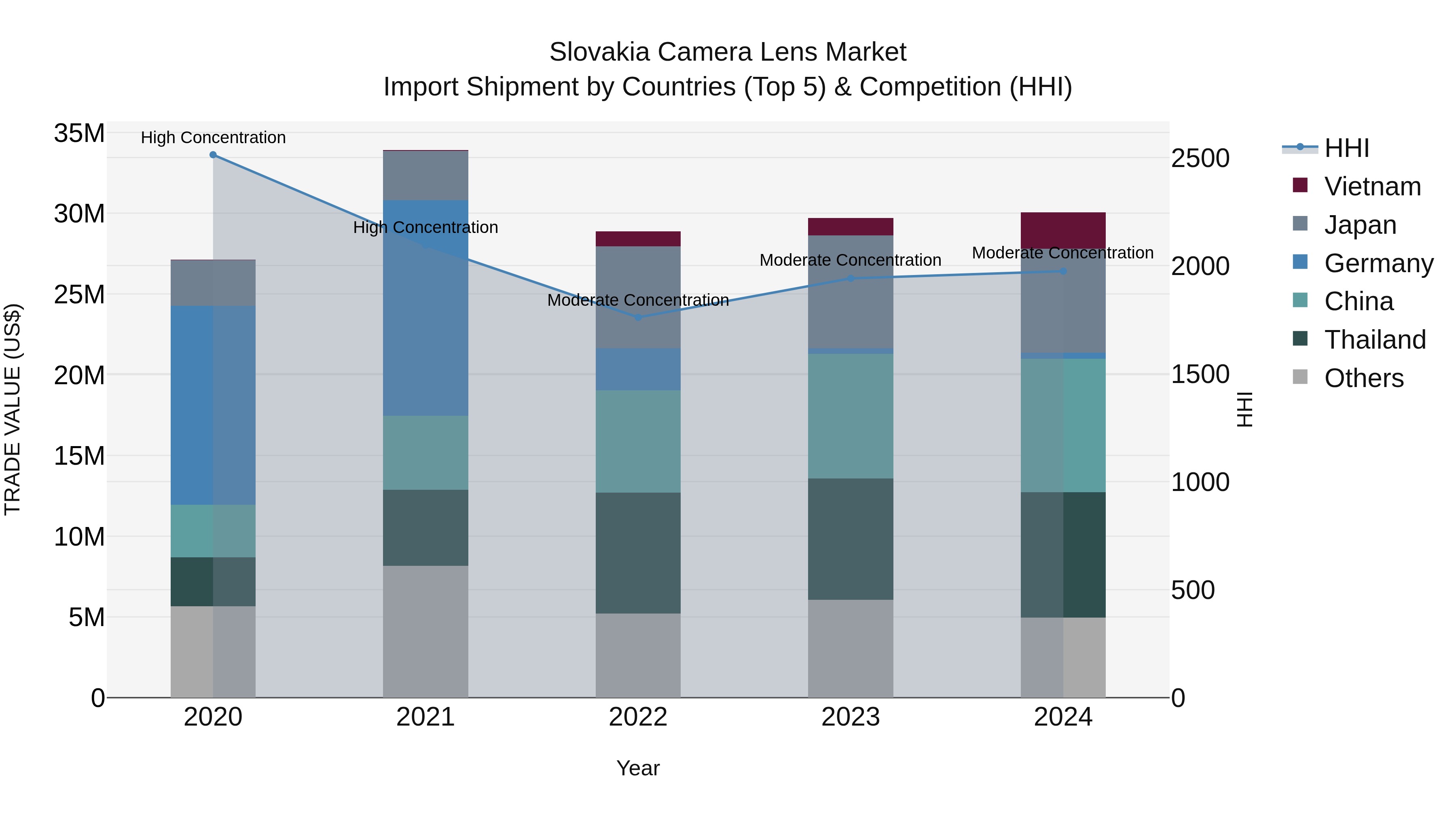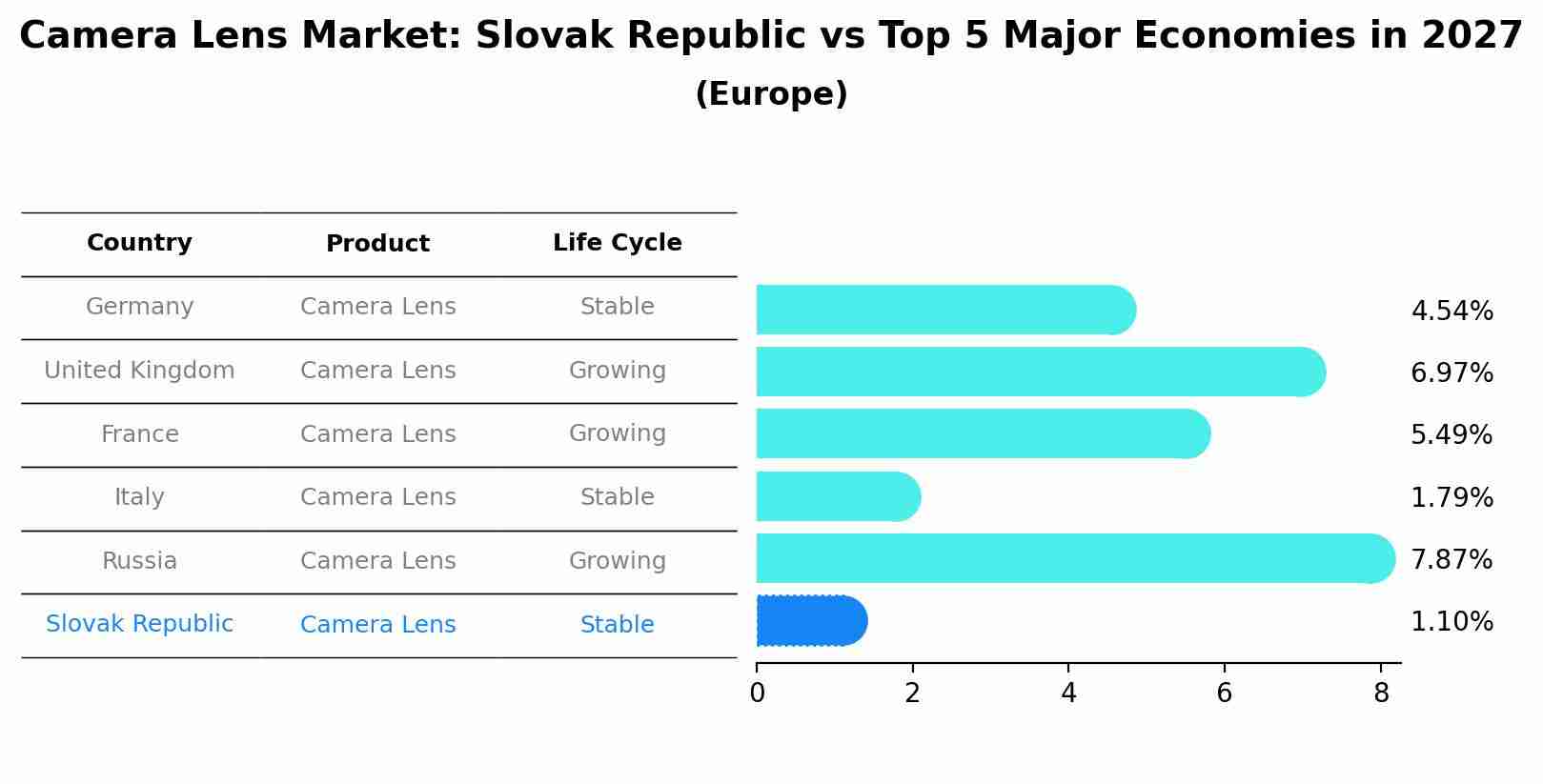Slovakia Camera Lens Market Outlook | COVID-19 IMPACT, Analysis, Industry, Forecast, Growth, Size, Trends, Share, Companies, Value & Revenue
| Product Code: ETC362420 | Publication Date: Aug 2022 | Updated Date: Nov 2025 | Product Type: Market Research Report | |
| Publisher: 6Wresearch | Author: Ravi Bhandari | No. of Pages: 75 | No. of Figures: 35 | No. of Tables: 20 |
Slovakia Camera Lens Market Top 5 Importing Countries and Market Competition (HHI) Analysis
Slovakia`s camera lens import Market Top 5 Importing Countries and Market Competition (HHI) Analysis in 2024 continued to see diverse sources, with top exporters including China, Thailand, Japan, Vietnam, and other European countries. Despite moderate concentration levels, the Market Top 5 Importing Countries and Market Competition (HHI) Analysis maintained steady growth, with a Compound Annual Growth Rate (CAGR) of 2.59% from 2020 to 2024. The growth rate for 2023-24 was 1.16%, indicating a stable upward trend in demand for camera lenses in Slovakia. The Market Top 5 Importing Countries and Market Competition (HHI) Analysis`s resilience and consistent growth signify opportunities for both domestic and international suppliers to tap into Slovakia`s evolving camera lens import landscape.

Camera Lens Market: Slovak Republic vs Top 5 Major Economies in 2027 (Europe)
The Camera Lens market in Slovak Republic is projected to grow at a stable growth rate of 1.10% by 2027, within the Europe region led by Germany, along with other countries like United Kingdom, France, Italy and Russia, collectively shaping a dynamic and evolving market environment driven by innovation and increasing adoption of emerging technologies.

Slovakia Camera Lens Market Synopsis
The Slovakia camera lens market is characterized by a growing demand for high-quality lenses driven by a rising interest in photography and videography among consumers. Key players in the market offer a diverse range of lenses catering to various needs, from wide-angle and telephoto lenses to macro and prime lenses. The market is witnessing a trend towards mirrorless cameras, prompting manufacturers to focus on developing lenses compatible with these systems. Additionally, advancements in technology such as image stabilization and autofocus capabilities are influencing consumer preferences for camera lenses. With a competitive landscape and increasing emphasis on innovation and product differentiation, the Slovakia camera lens market is poised for further growth and evolution in the coming years.
Slovakia Camera Lens Market Trends
The Slovakia Camera Lens Market is experiencing a shift towards mirrorless camera systems, driving demand for compatible lenses with advanced features such as fast autofocus and optical image stabilization. Consumers are also showing a preference for versatile zoom lenses that cover a wide range of focal lengths, offering flexibility for various photography genres. Additionally, there is a growing interest in high-quality prime lenses among photography enthusiasts looking to achieve superior image quality and artistic effects. Manufacturers are responding to these trends by introducing innovative lens technologies, including improved coatings for reduced ghosting and flare, as well as lightweight and compact designs for enhanced portability. Overall, the Slovakia Camera Lens Market is witnessing a trend towards performance-driven and versatile lenses catering to the diverse needs of photographers in the region.
Slovakia Camera Lens Market Challenges
In the Slovakia Camera Lens Market, one of the key challenges faced is increasing competition from online retailers and parallel imports. This has led to pricing pressures for local retailers, impacting their profitability. Additionally, the market is relatively small compared to other European countries, limiting the growth opportunities for camera lens manufacturers and retailers. Another challenge is the rapid advancement of smartphone camera technology, which has led to a decline in demand for standalone camera lenses. To stay competitive, companies in the Slovakia Camera Lens Market need to focus on product differentiation, marketing strategies, and customer service to attract and retain customers in this evolving landscape.
Slovakia Camera Lens Market Investment Opportunities
The Slovakia Camera Lens Market offers promising investment opportunities for companies involved in the production and distribution of high-quality camera lenses. With the increasing popularity of photography and videography among consumers, there is a growing demand for advanced and innovative camera lenses in Slovakia. Investing in research and development to create cutting-edge lens technology, expanding distribution channels to reach a wider audience, and establishing partnerships with camera manufacturers can help investors capitalize on this market growth. Additionally, focusing on the trend of social media content creation and the rise of influencers can provide a strategic direction for investment in the Slovakia Camera Lens Market. Overall, investing in this market segment presents a lucrative opportunity for companies looking to tap into the thriving photography industry in Slovakia.
Jordan Agar Market Government Policies
Government policies related to the Slovakia Camera Lens Market focus primarily on import regulations, taxation, and intellectual property rights protection. Slovakia is a member of the European Union, so market access is facilitated through EU trade agreements. Import regulations ensure that camera lenses entering the market meet quality and safety standards set by the EU. Taxation policies may impact the price of camera lenses, with VAT rates typically applied to consumer purchases. Additionally, intellectual property rights protection is enforced to safeguard the innovations and designs of camera lens manufacturers operating in Slovakia. Overall, government policies aim to create a fair and competitive environment for camera lens suppliers while ensuring consumer safety and protecting intellectual property rights.
Slovakia Camera Lens Market Future Outlook
The Slovakia Camera Lens Market is expected to experience steady growth in the coming years, driven by the increasing popularity of photography as a hobby and the rising demand for high-quality images in various industries. Technological advancements in camera lens technology, such as the development of compact and lightweight lenses with superior optical performance, are also anticipated to fuel market growth. Additionally, the growing adoption of mirrorless cameras among photography enthusiasts and professionals is expected to create opportunities for lens manufacturers. However, challenges such as competition from smartphone cameras and economic uncertainties may impact the market to some extent. Overall, the Slovakia Camera Lens Market is poised for expansion, with innovation and evolving consumer preferences shaping its future trajectory.
Key Highlights of the Report:
- Slovakia Camera Lens Market Outlook
- Market Size of Slovakia Camera Lens Market, 2021
- Forecast of Slovakia Camera Lens Market, 2031
- Historical Data and Forecast of Slovakia Camera Lens Revenues & Volume for the Period 2018 - 2031
- Slovakia Camera Lens Market Trend Evolution
- Slovakia Camera Lens Market Drivers and Challenges
- Slovakia Camera Lens Price Trends
- Slovakia Camera Lens Porter's Five Forces
- Slovakia Camera Lens Industry Life Cycle
- Historical Data and Forecast of Slovakia Camera Lens Market Revenues & Volume By Application for the Period 2018 - 2031
- Historical Data and Forecast of Slovakia Camera Lens Market Revenues & Volume By Consumer Electronics for the Period 2018 - 2031
- Historical Data and Forecast of Slovakia Camera Lens Market Revenues & Volume By Automotive for the Period 2018 - 2031
- Historical Data and Forecast of Slovakia Camera Lens Market Revenues & Volume By Medical for the Period 2018 - 2031
- Historical Data and Forecast of Slovakia Camera Lens Market Revenues & Volume By Other Applications for the Period 2018 - 2031
- Historical Data and Forecast of Slovakia Camera Lens Market Revenues & Volume By Distribution Channel for the Period 2018 - 2031
- Historical Data and Forecast of Slovakia Camera Lens Market Revenues & Volume By Online for the Period 2018 - 2031
- Historical Data and Forecast of Slovakia Camera Lens Market Revenues & Volume By Offline for the Period 2018 - 2031
- Slovakia Camera Lens Import Export Trade Statistics
- Market Opportunity Assessment By Application
- Market Opportunity Assessment By Distribution Channel
- Slovakia Camera Lens Top Companies Market Share
- Slovakia Camera Lens Competitive Benchmarking By Technical and Operational Parameters
- Slovakia Camera Lens Company Profiles
- Slovakia Camera Lens Key Strategic Recommendations
Frequently Asked Questions About the Market Study (FAQs):
- Single User License$ 1,995
- Department License$ 2,400
- Site License$ 3,120
- Global License$ 3,795
Search
Thought Leadership and Analyst Meet
Our Clients
Related Reports
- Canada Oil and Gas Market (2026-2032) | Share, Segmentation, Value, Industry, Trends, Forecast, Analysis, Size & Revenue, Growth, Competitive Landscape, Outlook, Companies
- Germany Breakfast Food Market (2026-2032) | Industry, Share, Growth, Size, Companies, Value, Analysis, Revenue, Trends, Forecast & Outlook
- Australia Briquette Market (2025-2031) | Growth, Size, Revenue, Forecast, Analysis, Trends, Value, Share, Industry & Companies
- Vietnam System Integrator Market (2025-2031) | Size, Companies, Analysis, Industry, Value, Forecast, Growth, Trends, Revenue & Share
- ASEAN and Thailand Brain Health Supplements Market (2025-2031) | Strategy, Consumer Insights, Analysis, Investment Trends, Opportunities, Growth, Size, Share, Industry, Revenue, Segments, Value, Segmentation, Supply, Forecast, Restraints, Outlook, Competition, Drivers, Trends, Demand, Pricing Analysis, Competitive, Strategic Insights, Companies, Challenges
- ASEAN Bearings Market (2025-2031) | Strategy, Consumer Insights, Analysis, Investment Trends, Opportunities, Growth, Size, Share, Industry, Revenue, Segments, Value, Segmentation, Supply, Forecast, Restraints, Outlook, Competition, Drivers, Trends, Demand, Pricing Analysis, Competitive, Strategic Insights, Companies, Challenges
- Europe Flooring Market (2025-2031) | Outlook, Share, Industry, Trends, Forecast, Companies, Revenue, Size, Analysis, Growth & Value
- Saudi Arabia Manlift Market (2025-2031) | Outlook, Size, Growth, Trends, Companies, Industry, Revenue, Value, Share, Forecast & Analysis
- Uganda Excavator, Crane, and Wheel Loaders Market (2025-2031) | Strategy, Consumer Insights, Analysis, Investment Trends, Opportunities, Growth, Size, Share, Industry, Revenue, Segments, Value, Segmentation, Supply, Forecast, Restraints, Outlook, Competition, Drivers, Trends, Demand, Pricing Analysis, Competitive, Strategic Insights, Companies, Challenges
- Rwanda Excavator, Crane, and Wheel Loaders Market (2025-2031) | Strategy, Consumer Insights, Analysis, Investment Trends, Opportunities, Growth, Size, Share, Industry, Revenue, Segments, Value, Segmentation, Supply, Forecast, Restraints, Outlook, Competition, Drivers, Trends, Demand, Pricing Analysis, Competitive, Strategic Insights, Companies, Challenges
Industry Events and Analyst Meet
Whitepaper
- Middle East & Africa Commercial Security Market Click here to view more.
- Middle East & Africa Fire Safety Systems & Equipment Market Click here to view more.
- GCC Drone Market Click here to view more.
- Middle East Lighting Fixture Market Click here to view more.
- GCC Physical & Perimeter Security Market Click here to view more.
6WResearch In News
- Doha a strategic location for EV manufacturing hub: IPA Qatar
- Demand for luxury TVs surging in the GCC, says Samsung
- Empowering Growth: The Thriving Journey of Bangladesh’s Cable Industry
- Demand for luxury TVs surging in the GCC, says Samsung
- Video call with a traditional healer? Once unthinkable, it’s now common in South Africa
- Intelligent Buildings To Smooth GCC’s Path To Net Zero


















